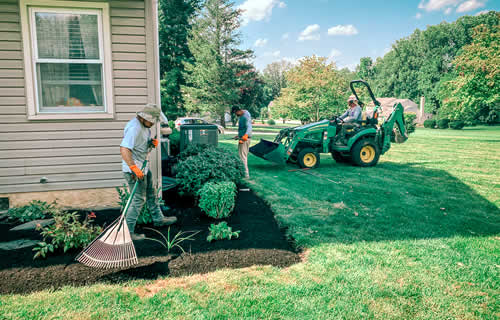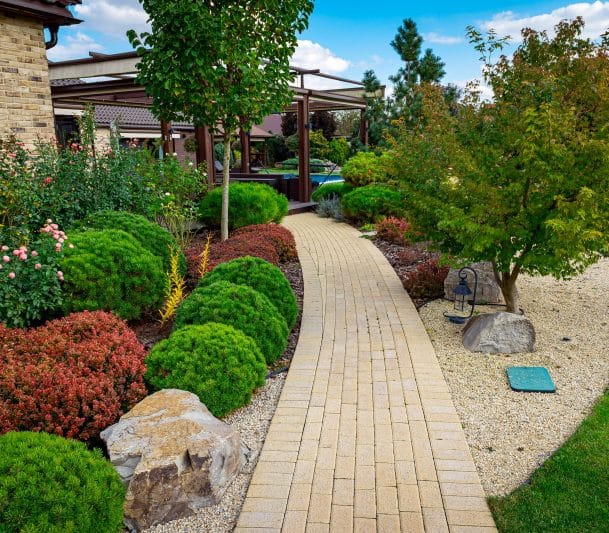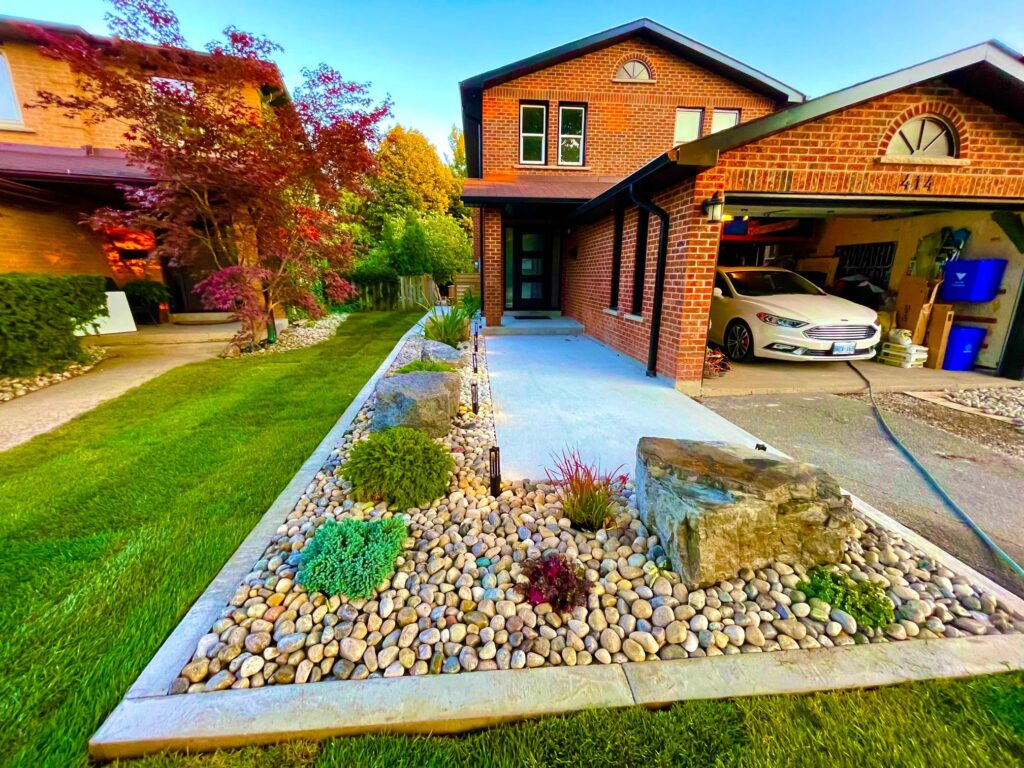Pro-level landscaping strategies for long-lasting outdoor beauty
Recognizing the Comprehensive Range of Works in Professional Landscape Design Services
The considerable range of professional landscaping services incorporates a range of fundamental elements - landscaping services. It includes landscape design concepts, plant choice, and hardscaping features. In addition, it attends to irrigation systems and upkeep methods. Each aspect plays a crucial duty in producing functional and cosmetically pleasing outside rooms. Comprehending how these parts interact can expose much about the art and scientific research of landscaping. The trip into this detailed area is simply starting.
Landscape Style Concepts
Reliable landscape design concepts are essential for producing unified outdoor rooms that enhance both visual appeal and performance (Learn More). These concepts lead the setup of elements within the landscape, making sure a natural aesthetic experience. Key components include balance, which disperses aesthetic weight equally; proportion, which relates the size of different aspects per other and the area; and unity, which develops a feeling of wholeness via constant motifs and materials

Plant Option and Setup
In the domain of professional landscape design, plant option and setup play a crucial duty in accomplishing a prospering garden. Stressing native plant benefits, seasonal considerations, and the specific dirt and sunlight requirements of each types guarantees a lasting and aesthetically pleasing landscape. Cautious planning in these areas not just enhances biodiversity however additionally promotes lasting ecological health and wellness.
Indigenous Plant Advantages
Why should home owners think about indigenous plants for their landscaping jobs? Indigenous plants offer many advantages that boost both appearances and ecological sustainability. They are well-adapted to local climates, needing less water and upkeep compared to non-native types. This resilience lowers the requirement for chemical plant foods and pesticides, promoting a healthier environment. Additionally, native plants give habitat and food for neighborhood wildlife, consisting of pollinators, which can increase biodiversity in household areas. Their knowledge with local dirt and weather additionally results in far better growth prices and long life. By selecting indigenous plants, homeowners not only develop visually attractive landscapes yet also add to eco-friendly conservation, making a positive effect on their local atmosphere. Subsequently, indigenous plants represent a wise selection for landscape design projects.
Seasonal Plant Considerations
Home owners who have actually welcomed indigenous plants in their landscape design can better boost their exterior areas by taking into consideration seasonal plant selections. By integrating plants that flourish in certain periods, they can develop vibrant and aesthetically attractive landscapes throughout the year. Springtime might introduce vivid blossoms like daffodils and tulips, while summer can showcase rich foliage and vibrant perennials. Autumn introduces a combination of cozy tones with goldenrods and asters, while winter months can be emphasized with evergreens and decorative grasses for texture. Professional landscapers frequently suggest choosing plants that not only complement existing native species but also provide year-round interest and assistance neighborhood wild animals. This thoughtful strategy to seasonal plant choice guarantees a continually evolving and lasting yard atmosphere.
Soil and Sunlight Needs
Effective landscape design rests on comprehending the certain soil and sunlight demands of plants. Various types flourish under varying conditions, calling for a mindful evaluation of both elements during the option procedure. Soil types, such as sandy, clay, or fertile, impact drain, nutrient schedule, and root growth. Additionally, pH degrees can affect plant wellness, necessitating soil screening to ascertain viability. Sunlight needs vary considerably; some plants prosper completely sun, while others favor partial or complete color. An expert landscaper takes into consideration these elements to ensure peak development and aesthetic allure. By straightening plant selections with the environment's specific features, landscapes can accomplish sustainability, resilience, and visual harmony, eventually resulting in effective plant establishment and lasting maintenance.
Hardscaping Attributes and Construction

While landscape design often evokes photos of lavish greenery and dynamic blossoms, hardscaping attributes play an essential duty in specifying outdoor areas. These aspects, which consist of patio areas, walkways, keeping wall surfaces, and attractive stonework, give structure and functionality to lawns and yards. Hardscaping makes use of products such as concrete, wood, brick, and stone, enabling diverse layouts that enhance the natural landscape.
The building and construction of hardscaping functions needs cautious preparation and implementation to ensure toughness and visual allure. Experts evaluate website conditions, drainage, and spatial connections to produce cohesive outside atmospheres. Proper installation techniques are essential, as they avoid issues like erosion and changing with time.
Including hardscaping not just improves the visual interest of a residential or commercial property but also promotes exterior tasks, making it an essential aspect of thorough landscape design services. Eventually, thoughtful hardscaping adds to both the functionality and beauty of exterior areas.
Irrigation Systems and Water Monitoring
Efficient irrigation systems and water monitoring are essential elements of professional landscape design, as they ensure that plants receive the necessary hydration for excellent development. These systems can vary from straightforward drip watering setups to innovative automatic lawn sprinkler, made to satisfy the specific demands of diverse landscapes. Proper water administration not only enhances water use, reducing waste, but likewise boosts plant wellness and minimizes disease risks.
Landscaping experts assess various elements, including soil type, plant types, and regional environment, to create tailored watering solutions. Furthermore, incorporating rainwater harvesting techniques can further enhance sustainability and efficiency. Routine maintenance of watering systems is necessary to preserve capability and protect against leakages, which can lead to water loss and enhanced prices (Learn More). Inevitably, a properly designed irrigation system plays a pivotal role in protecting the aesthetic charm of outside areas while advertising eco-friendly stewardship within specialist landscape design techniques
Lawn Treatment and Maintenance Approaches
Yard care and upkeep techniques are basic for accomplishing a lush, healthy and balanced yard that improves the general landscape. These techniques incorporate numerous methods intended at advertising ideal development and visual charm. Normal mowing is necessary, as it encourages thick, also growth while protecting the original source against weeds from establishing. In addition, proper fertilizing provides essential nutrients, with applications tailored to the certain yard type and dirt problems.
Watering practices need to concentrate on deep, occasional irrigation to motivate origin development, while aeration boosts soil structure and advertises nutrient absorption. Insect and condition management is likewise critical; identifying problems early allows for reliable therapies that reduce damages.
Finally, overseeding can revitalize slim or broken yards, enhancing thickness and color. By applying these targeted yard care techniques, landscape design specialists can ensure that yards continue to be healthy and vibrant throughout the periods, substantially adding to the overall charm of the home
Seasonal Landscape Care and Upkeep
As the periods modification, correct landscape care comes to be important for preserving the health and wellness and charm of exterior spaces. Each season provides distinct difficulties and requirements. In spring, landscape professionals concentrate on pruning, planting, and feeding to encourage development. Summertime demands routine watering, weed control, and pest administration to safeguard newly established plants.

Throughout the year, seasonal landscape upkeep assurances that exterior locations remain healthy and balanced and visually appealing. Expert services can offer tailored maintenance strategies that adjust to the details demands of each season, allowing homeowner to take pleasure in vibrant landscapes year-round. On the whole, seasonal treatment is an essential facet of specialist landscaping that advertises longevity and visual value.

Lasting Landscape Design Practices
A growing variety of homeowner are embracing lasting landscape design techniques to create eco friendly outside rooms. These methods focus on conserving resources, enhancing biodiversity, and reducing ecological impact. Native plants are commonly chosen for their low water demands and compatibility with neighborhood communities, decreasing the need for chemical fertilizers and chemicals. Rainfall gardens and permeable paving are used to take care of stormwater overflow, promoting groundwater recharge and decreasing erosion.
Sustainable landscape design integrates organic horticulture methods that prioritize dirt health and wellness and promote all-natural bug control. Efficient irrigation systems, such as drip watering and rainwater harvesting, help maximize water use. Additionally, landscape developers progressively support for making use of recycled products, such as recovered wood and stones, to lessen waste. By taking on these sustainable practices, homeowner not only contribute to eco-friendly conservation but also create visually pleasing settings that can prosper with minimal maintenance.
Frequently Asked Concerns
The length of time Does a Landscaping Project Commonly Require To Full?
Normally, a landscaping task can take anywhere from a few days to numerous weeks to complete, relying on the task's complexity, layout, and size requirements. Aspects such as climate and resource schedule additionally affect timelines.
What Factors Impact the Price of Landscape Design Services?
Various variables affect landscape design service expenses, including project dimension, design complexity, material top quality, labor expenses, geographical area, and seasonal need. Each element adds distinctly to the overall financial demands of a landscape design job.
Are Landscape Design Solutions Available Year-Round?
Landscape design services are generally offered year-round, although schedule might vary based upon region, seasonal climate condition, and details service offerings. Some services could be restricted throughout severe weather condition or off-peak periods.
Do Landscaping Firms Deal Guarantees on Their Job?
Many landscaping companies do supply service warranties on their work, which can vary in length and insurance coverage. Customers are encouraged to make inquiries regarding specific terms, ensuring they recognize what is guaranteed and any kind of conditions that apply.
Can I Design My Landscape Without Specialist Aid?
Yes, people can develop their landscapes without specialist help. They might do not have knowledge in plant choice, format, and environmental factors to consider, potentially leading to much less reliable designs that might call for costly adjustments later.
In the domain of specialist landscape design, plant choice and installment play a crucial function in accomplishing a prospering yard. Homeowners that have accepted native plants in their landscape design can better boost their outside rooms by taking into consideration seasonal plant choices. Effective landscape design pivots on recognizing the particular soil and sunlight needs of plants. Effective irrigation systems and water management are essential components of specialist landscape design, as they ensure that plants obtain the required hydration for ideal development. Landscape design experts evaluate different factors, including dirt type, plant species, and neighborhood climate, to develop customized irrigation remedies.